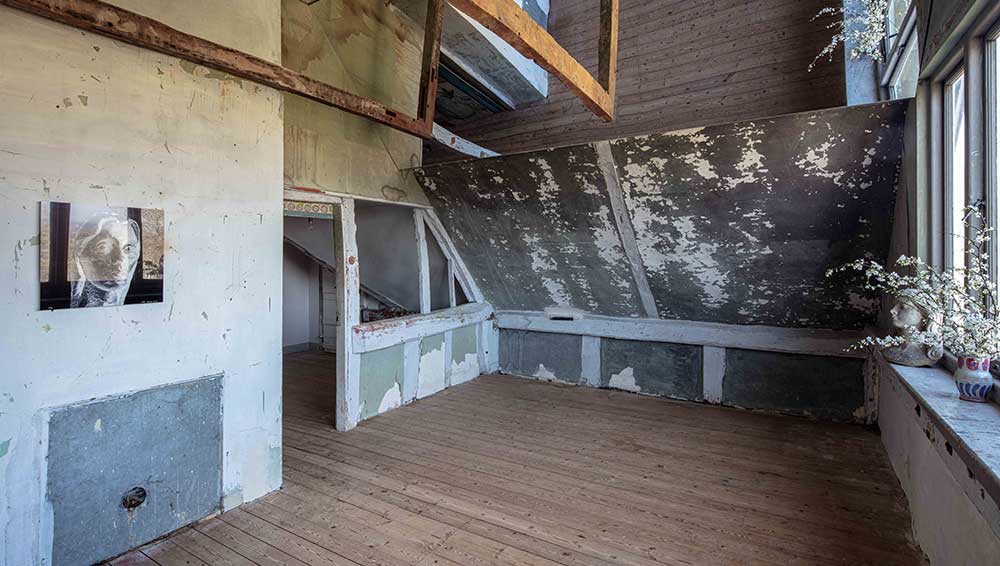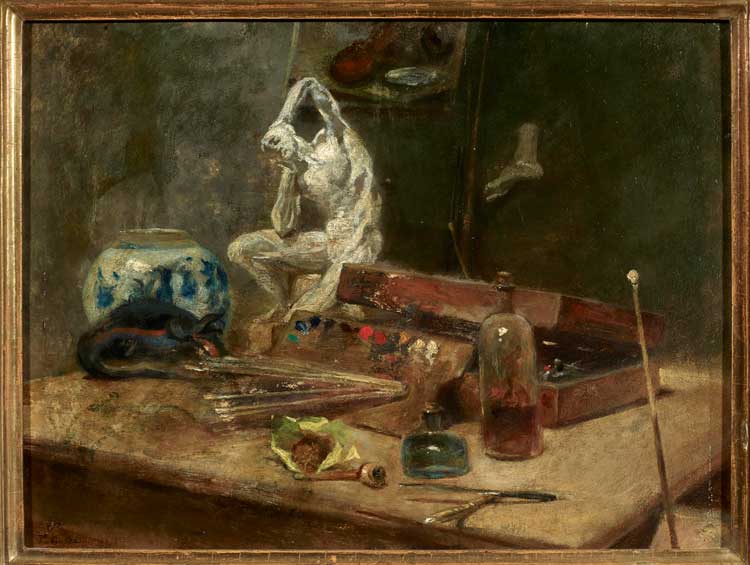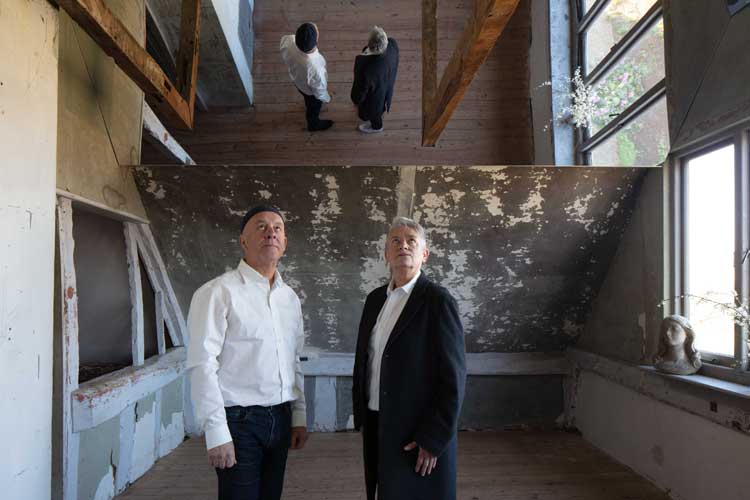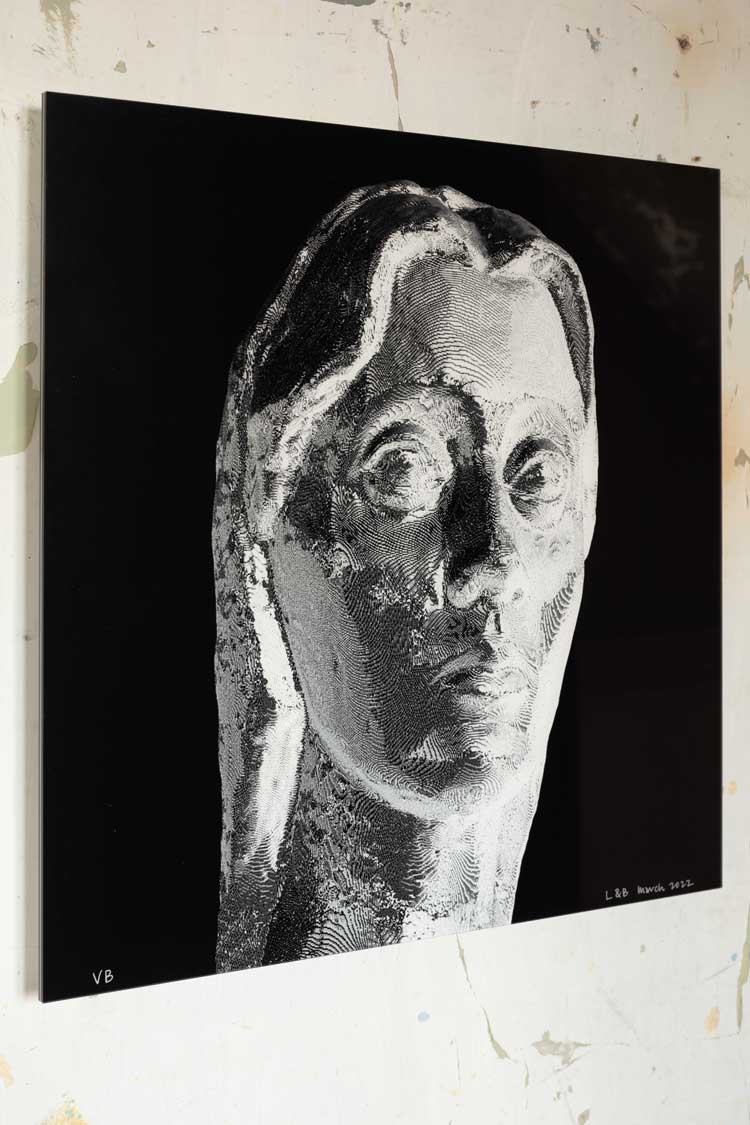
Near Heaven by Langlands & Bell at Charleston, 2022. Photo: Richard Waite.
Charleston, East Sussex
2 April – 29 August 2022
by BETH WILLIAMSON
Ben Langlands and Nikki Bell, who have worked together as Langlands & Bell for more than 40 years, currently have three exhibitions at Charleston, the former Sussex home of Vanessa and Clive Bell and a sanctuary for them and others of the Bloomsbury set, such as Roger Fry and Duncan Grant. The clean, architectural lines of Langlands & Bell’s work may, at first glance, seem to have little in common with Charleston, but there is more to it than that. Each aspect of their threefold presence here exists in its own right, strong in its singularity, stronger still and more nuanced in the possibilities it offers when considered as a whole. Alongside each other, and within the context of the site at Charleston, these contributions from Langlands & Bell offer something rare, a creative engagement with the world that is intuitive and sensitive, asking serious questions, offering visual pleasure and elements of humour, and all while laying itself bare to the scrutiny of public gaze.
-Photo-courtesy-of-the-artists.jpg)
Langlands & Bell, The Kitchen, 1978 (detail of Old Kitchen). Photo courtesy of the artists.
First, there is Ideas of Utopia, an exhibition of Langlands and Bell’s own sculptural works, from the remnants of The Kitchen (1978), their first collaboration, made while they were still students at Hornsey College of Art, through to other more recent works from 2018. A shared common culture and way of life were at the heart of the utopia that Thomas More (1437-1535) first wrote about in 1516, an imagined perfect world whose very name begged the question whether it was even possible (the Greek eu-topos means good place, while ou-topos mean no place or nowhere). Langlands & Bell’s Ideas of Utopia is really not so different. The Kitchen is a perfect place to begin, not only because it was their first collaborative work, but because only fragments remain after it was almost completely destroyed by fire in 1980. The suggestion is surely that utopias never last.
-Photo-courtesy-of-the-artists.jpg)
Langlands & Bell, The Kitchen, 1978 (detail of New Kitchen). Photo courtesy of the artists
Three-dimensional sculptural models of corporate, industrial, religious, domestic and political buildings line the walls. Each represents the footprint of a building, or group of buildings, that might be considered utopian in one sense or another. For instance, Highpoint (1990) depicts the apartment block of that name built in 1935, in Highgate, north London, by the émigré architect Berthold Lubetkin. This is flanked by representations of Keeling House (1957) in Bethnal Green, east London, designed by Denys Lasdun to meet the need for postwar social housing.
The largest and most imposing work is Ivrea (1991), which represents the collection of 10 buildings constructed by the Olivetti company throughout the 20th century. Adriano Olivetti wanted to build a utopian community, not just a business. The site therefore included a factory and offices, but also housing and a social complex including a theatre and a restaurant. Now the site is in partial ruin. Utopias are only skin deep and, if you scratch the surface, there is often unrest and dystopia beneath. This uneasy coexistence helps to make sense of the presence of Traces of Living (1986) in this exhibition. A table and chairs house discarded and found objects under glass, alongside architectural models of the inaccessible basements of buildings. Exposing dystopia (in the form of dead rats, spent candles and discarded plastic objects) in the midst of utopian communities certainly makes you question the value of both. However, the work Langlands & Bell present in this exhibition is not so much a critique of the subject as an observation. There is room for critique, but it is perhaps left for the viewer to draw their own conclusions in that respect.

Absent Artists: Jean Claude Dumont. Still Life in Artist's Studio.
Alongside Ideas of Utopia is Absent Artists, Langlands & Bell’s curatorial debut and an exquisite selection of artworks, mainly drawn from the collection of the former art dealer Katrin Bellinger. Their own interactive digital work The Artist’s Studio (2002) is also shown, underlining the idea of the artist’s studio as a private utopian space. Selecting artworks from Bellinger’s Collection in which the artist is absent and the studio empty, Langlands & Bell have also created Serpentine (2022), a wall, referencing the serpentine lines of William Hogarth’s book The Analysis of Beauty (1753). Serpentine bisects the gallery space, allowing for a display that is more amenable to the fluid movement of visitors and therefore facilitates the possibility of new connections to be made between the works on show. This fluidity, along with the deliberate lack of interpretation, means the curators relinquish control and positively encourage visitors to make up their own minds about the stories being told. I suspect, and hope, this might embolden visitors to talk to each other, to exchange ideas and form their own communities, even if only for a moment or two. Those sorts of fleeting exchanges enrich our lives and I think Langlands & Bell would like that.

Near Heaven by Langlands & Bell at Charleston, 2022. Photo: Richard Waite.
The other work the pair have created is less an exhibition than an intervention in the house itself, the first time this has been done since Charleston opened to the public. The result is Near Heaven, an installation in Vanessa Bell’s attic studio and named after the same phrase used by Bell’s daughter, Angelica. In the reified atmosphere of the attic studio, everything is pared back to a minimum. Even ascending the narrow stairs to the space gives a sense of retreat. Once in the small attic space, the air is chilled on a spring day and the cool air sharpens the senses. The bare walls and curtainless window underline the sense of simplicity. It is entirely appropriate, therefore, that Langlands & Bell have used a light touch here. The room is stripped back, a series of mirrors have been installed in the roof space reflecting the room and the garden, at times in infinite regress.

Near Heaven by Langlands & Bell at Charleston, 2022. Photo: Richard Waite.
A ghostly portrait of Vanessa Bell hangs on one wall. This gentle activation of the space leaves the viewer in control, their perspective influenced only by their physical position in the space and the changing seasons as they affect the garden below and its reflections above. In the clear light and crisp air of springtime, this space is spine-tingling. It is almost as if the ghost of Vanessa Bell is there with us, and that is quite an achievement.
In Ideas of Utopia, Absent Artists, and Near Heaven, Langlands & Bell use their own work and that of other artists to bring out important aspects of Charleston and its history. More importantly, perhaps, as living artists they reactivate its spaces and rejuvenate the ideas of its former occupants for contemporary times and viewers. Utopias are never quite what they seem, whatever form they might take.